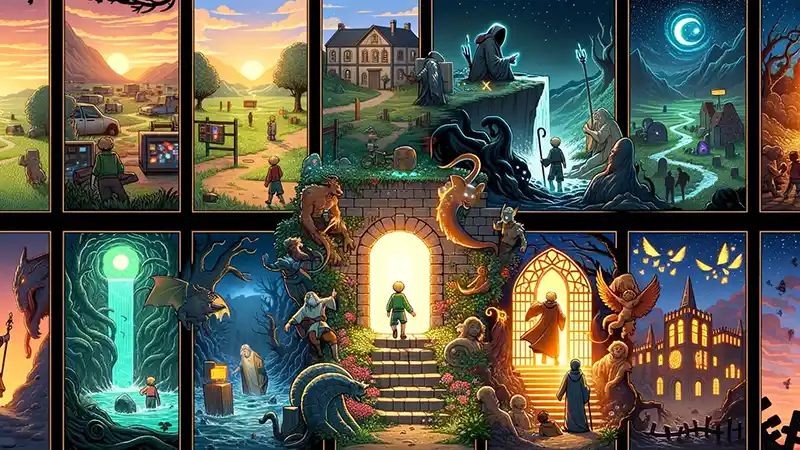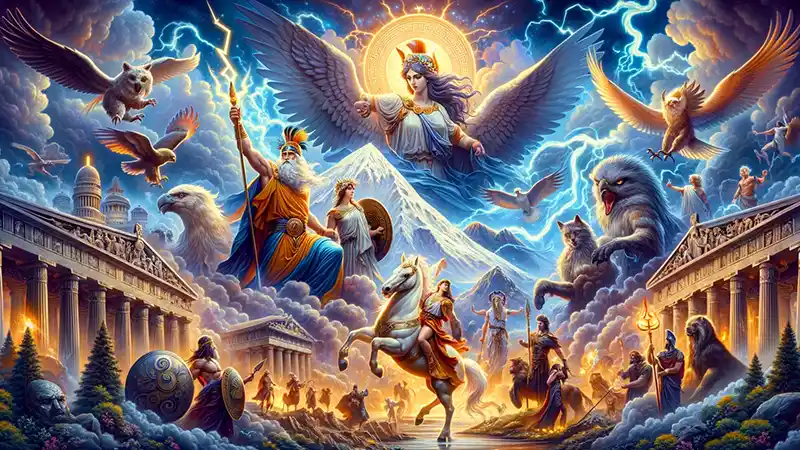This lesson dissects the age-old narrative structure that underpins countless stories, from Homer’s Odyssey to today’s cinematic epics. Understanding this journey and the roles that populate it is not just about analyzing literature; it’s about recognizing the patterns that shape our understanding of heroism, challenge, and transformation across cultures and ages. It’s a tool to engage students with the universal truths woven into the fabric of the stories they love, and it’s a testament to the timeless relevance of storytelling in human experience.
Learning Goals
- I will be able to identify and explain the stages of the Hero’s Journey, including the Call to Adventure, the Initiation, and the Return.
- I will be able to distinguish between different archetypes, such as the Mentor, Ally, Herald, Trickster, Shapeshifter, Guardian, and Shadow, within various narratives.
Process
- Either present and have students take down the hero’s journey note or distribute it as a handout.
- Distribute the archetypes handout.
- Have students read and summarize the handout on the worksheet.
Assessment
Either take up the worksheet together or collect and mark it.
Materials
12 Stages of a Hero's Journey
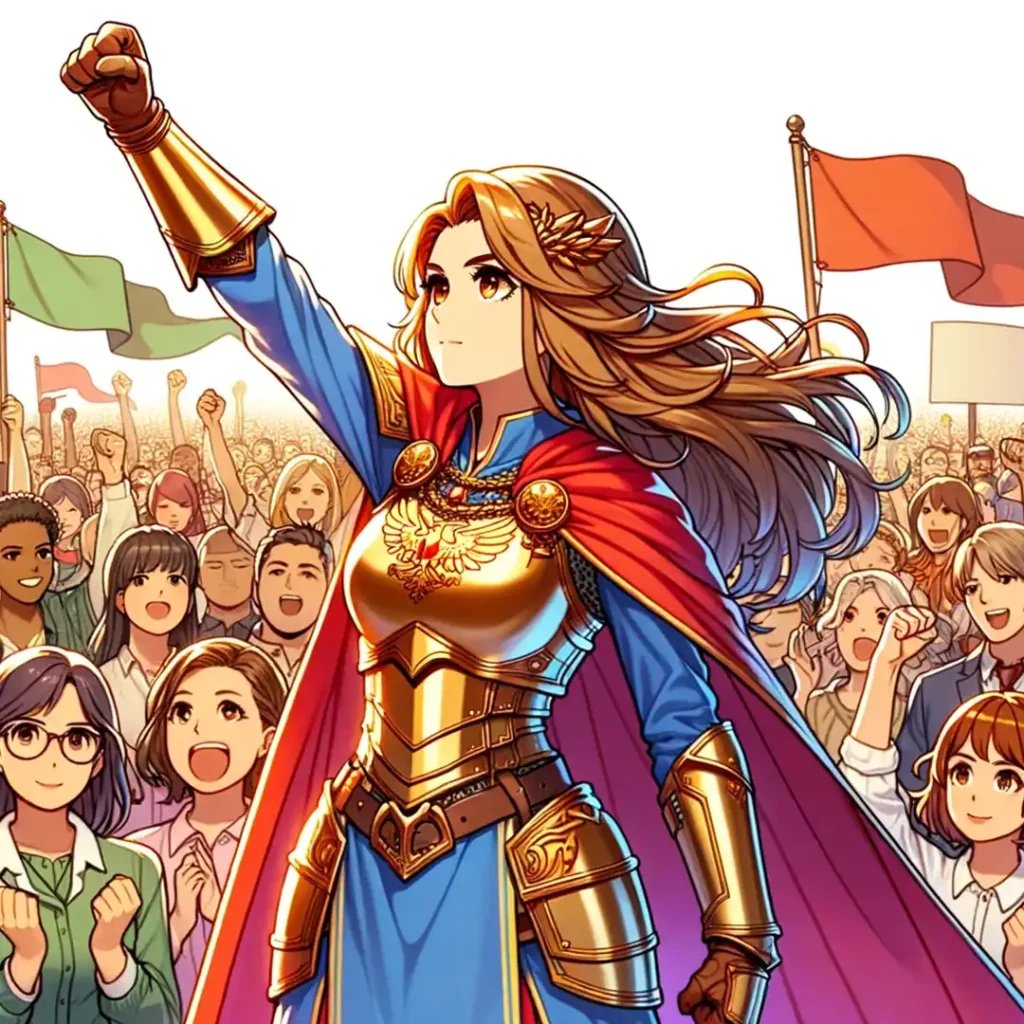
1. Ordinary World
- The hero is a normal person or member of society
- The hero’s surroundings are common, comfortable, mundane, or even boring
2. Call to Adventure
- The call establishes the stakes of the game and makes clear the hero’s goals
- The hero learns what is at stake
The hero is expected to leave the Ordinary World - The call is usually made by a herald
3. Refusal of the Call
- Hero expresses his, her, or their reluctance
- Hero does not wish to commit to the journey
4. Meeting the Mentor
- Mentor serves as a motivator or teacher to the hero
- He, she, or they helps the hero prepare for the unknown
- Old hero passes the torch
However, the mentor can only go so far…
5. Crossing the First Threshold
- Hero finally agrees to face the conflict
- Hero is willing to accept the consequences of entering the special world
- Adventure gets moving!
6. The Special World
- The hero is tested.
- We meet new allies.
- We discover new enemies.
7. Approach to the Inmost Cave
- Cave may symbolize where a secret object may be found
- Cave may be where the enemy is hiding or the edge of some dangerous place
- Many heroes pause before entering to prepare a plan to outwit the enemy
8. The Supreme Ordeal
- Hero is forced to confront his, her, or their greatest fear!
- Hero faces a possibility of death
Audience or reader is held in suspense
9. Reward
- Hero overcomes his, her, or their obstacle and takes possession of the reward
- The reward can be an object, person, knowledge, sword, secret, etc.
10. The Road Back
- This stage marks the hero’s return to the Ordinary World
- However, hostile forces still rage after the hero…he’ not out of the woods yet
11. The Resurrection
- This state marks a second life and death moment for the hero.
- He cannot quite reach the Ordinary World just yet.
12. Return with Elixir
- Hero returns to the Ordinary World with new treasure, knowledge, or lesson from the special world.
- Hero takes his, her, or their new experiences from the Special World home.
Archetypes in The Hero’s Journey
An archetype is a very typical example of a certain person or thing, or an original that has been imitated. In the context of literature, art, and psychology, the term has specific nuances:
Both of the following definitions are important to us:
Literature and Art: An archetype can refer to a character, a theme, a symbol, or even a setting that represents universal patterns of human nature. It is also commonly used in mythology, where certain figures or themes recur across various cultures and are considered archetypal because they are imbued with a certain universal significance. For example, the “hero” archetype is seen in characters that embody courage and adventure; the “mentor” archetype is a figure that guides or aids the hero.
Psychology: The term was adopted by Carl Jung, who used it to describe his theory of the human psyche. He believed archetypes are innate, universal prototypes for ideas and may be used to interpret observations. In Jungian psychology, archetypes are thought of as universal, archaic symbols and images that derive from the collective unconscious and are the psychic counterpart of instinct. They are inherited potentials that are actualized when they enter consciousness as images or manifest in behavior on interaction with the external world.
Fill out the archetypes worksheet, using the following information:
The Hero
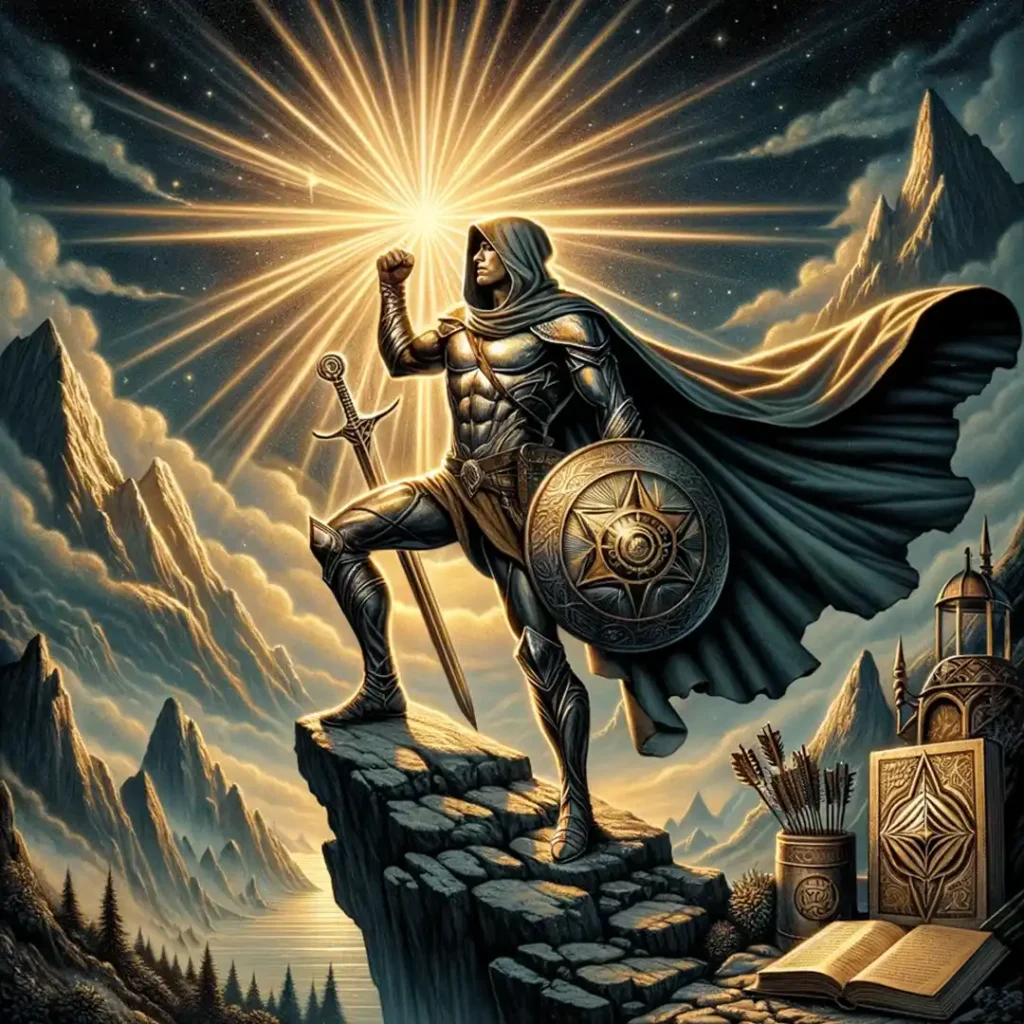
The archetype of the Hero represents the protagonist of a story who is often called to leave their ordinary world and enter into a new, challenging environment where they must face a series of trials. The Hero is usually portrayed as a character who seeks something of great value, whether it be a physical object, knowledge, wisdom, or peace. The journey they undertake is as much an external adventure as it is an internal transformation, with the Hero often experiencing significant personal growth and development.
Characteristics of the Hero archetype include courage, perseverance, sacrifice, and the willingness to face the unknown. The Hero is often, but not always, destined for greatness or has an inherent nobility, either in their character or their lineage. They typically possess a strong moral compass, and their actions are usually driven by a sense of duty, love, or honor.
Harry Potter, from J.K. Rowling’s “Harry Potter” series, is an exemplary literary Hero.
Luke Skywalker from “Star Wars” is a classic cinematic Hero.
The Mentor
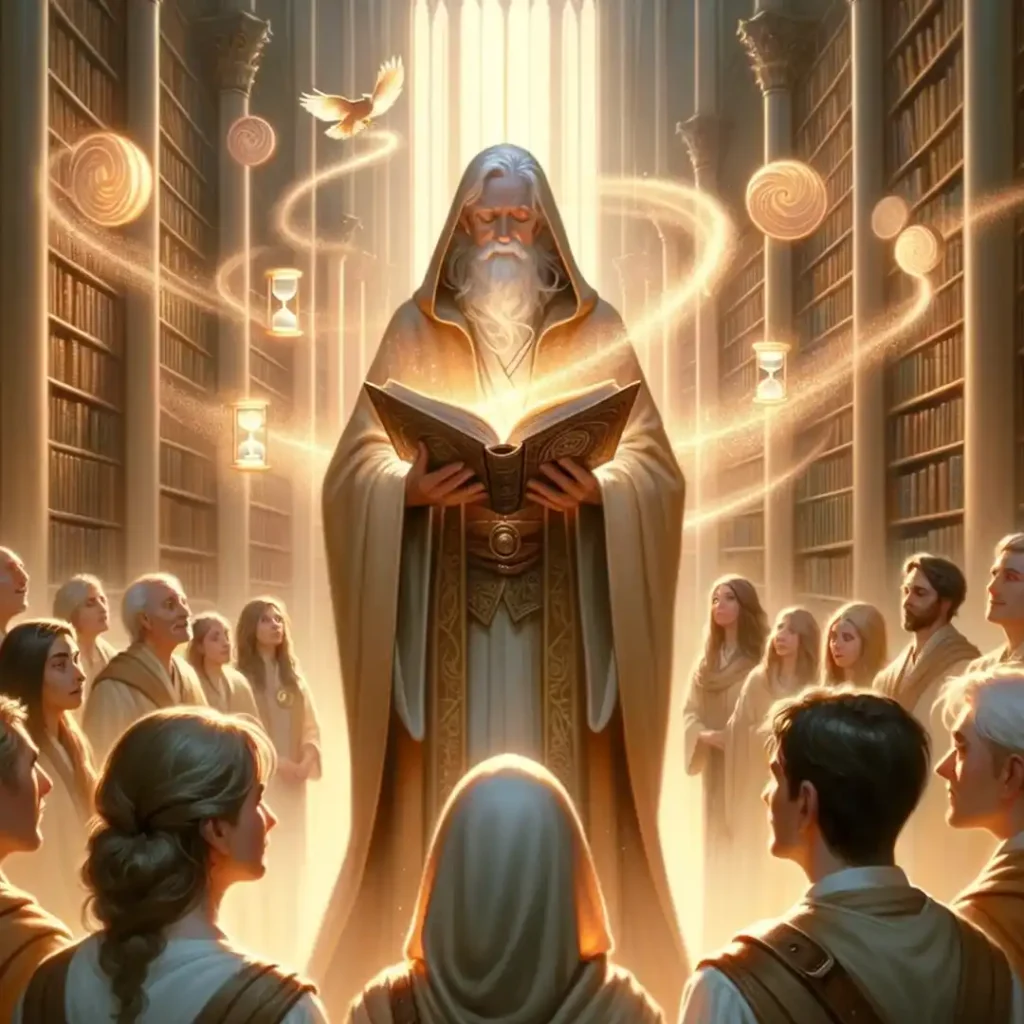
The archetype of the Mentor represents the guide or teacher who assists the Hero on their journey. This figure often possesses wisdom and experience and serves to motivate, inspire, or educate the Hero, helping them to overcome doubts and prepare for the challenges ahead. The Mentor can be a protective presence, offering gifts of knowledge or tools, crucial advice, or even magical support to the Hero. They are a source of spiritual and moral guidance and often embody the Hero’s aspirations.
Characteristics of the Mentor archetype include wisdom, knowledge, insight, and often a certain degree of patience and compassion. They are usually portrayed as a benevolent figure, though their methods of teaching may sometimes seem harsh or challenging. Mentors are critical in helping the Hero to build the necessary skills or acquire the knowledge needed to overcome impending trials. Their influence is pivotal to the Hero’s development and in shaping the path that will lead to maturity or fulfillment of the quest.
In literature, Gandalf from J.R.R. Tolkien’s “The Lord of the Rings” series is a quintessential Mentor. As a wise wizard, Gandalf guides the young hobbit, Frodo Baggins, on his perilous journey to destroy the One Ring. Gandalf offers wisdom, support, and guidance, not only to Frodo but to the entire Fellowship, steering them through their darkest moments.
In cinema, Mr. Miyagi from “The Karate Kid” is an iconic Mentor. He teaches Daniel LaRusso not just the physical skills of karate but also valuable life lessons about balance, patience, and respect, transforming Daniel not just into a skilled martial artist but into a more confident and resilient individual.
Allies
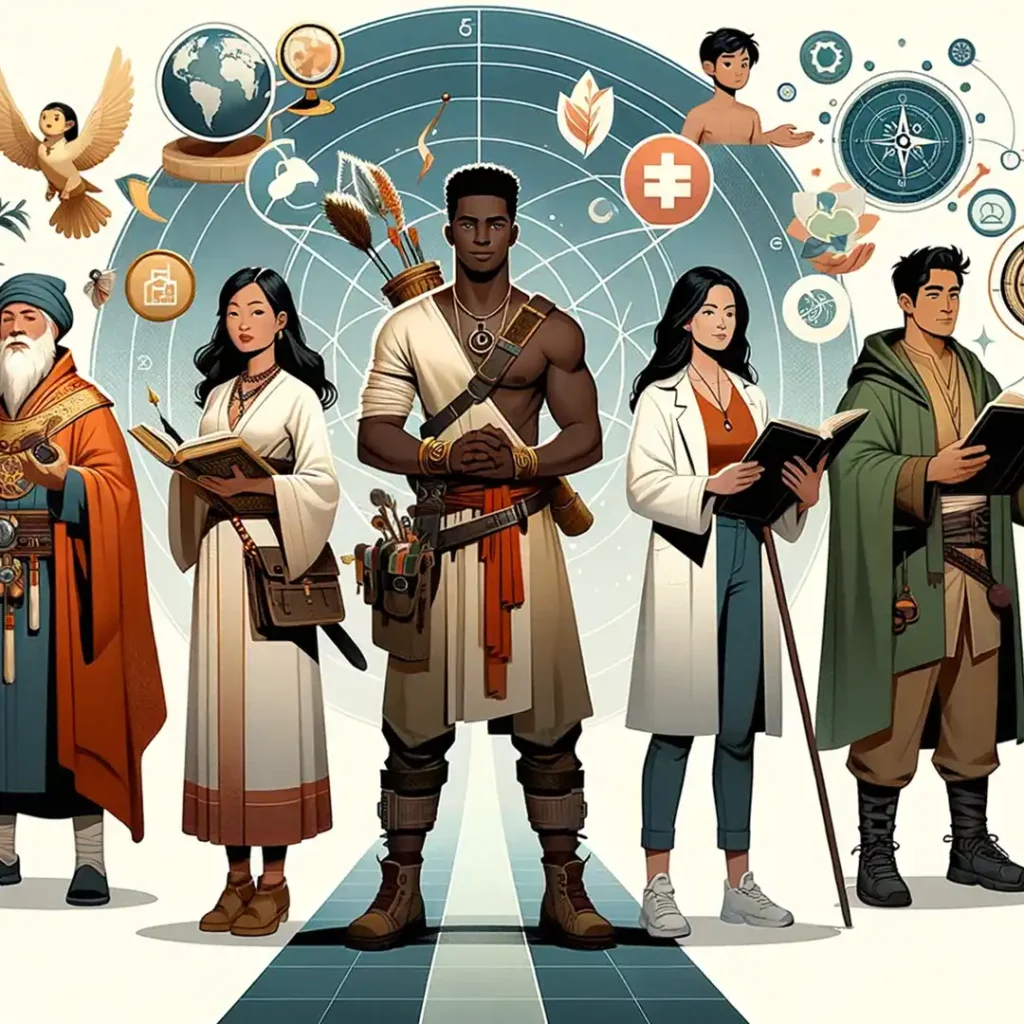
The archetype of the Ally represents a companion or supporter of the Hero on their journey, playing a crucial role in the Hero’s adventure. Allies come in many forms, sometimes as friends, lovers, or family members, and they often complement the Hero’s strengths or compensate for their weaknesses. An Ally may also provide emotional support, encouragement, and camaraderie, which are essential as the Hero faces the unknown. These characters can also inject humor, provide a sounding board for ideas, and assist in problem-solving throughout the narrative.
Characteristics of the Ally archetype include loyalty, devotion, and the willingness to face shared risks. While the Hero may be the primary focus of the narrative, Allies are often well-developed characters with their own quirks, backgrounds, and arcs. They contribute significantly to the plot, aid in the development of the Hero, and sometimes undergo their own growth and transformation. Allies may challenge the Hero’s ideas and actions, fostering critical growth and change.
In literature, Samwise Gamgee from J.R.R. Tolkien’s “The Lord of the Rings” series epitomizes the Ally archetype. Sam is the steadfast companion of Frodo Baggins, offering unwavering loyalty, physical assistance, and emotional support. His down-to-earth wisdom, courage, and dedication play a pivotal role in the success of Frodo’s mission to destroy the One Ring.
In movies, Ron Weasley and Hermione Granger from the “Harry Potter” series are exemplary Allies. They support Harry in various ways: Ron provides loyalty and relief from the weight of Harry’s destiny, while Hermione offers intelligence, resourcefulness, and a voice of reason. Both characters contribute significantly to Harry’s journey and to the triumph over the challenges they face together.
The Herald
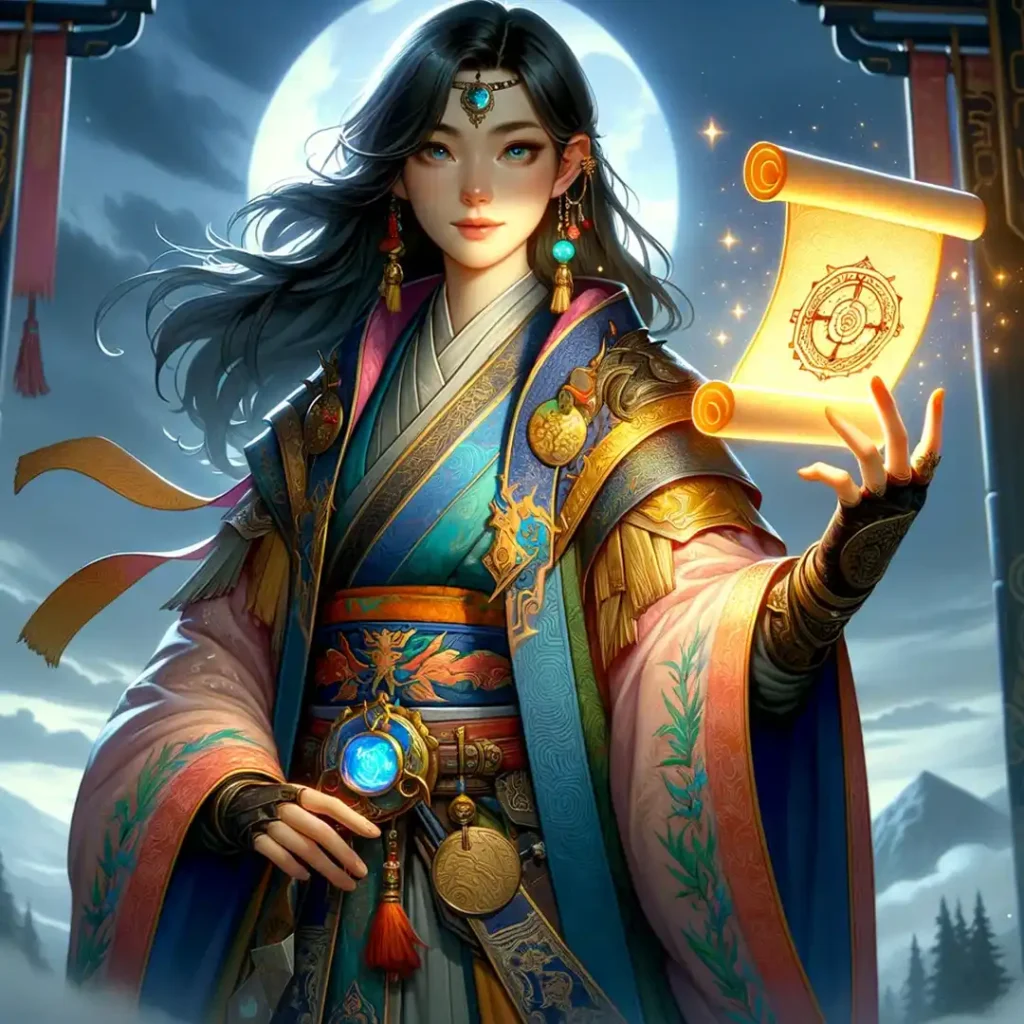
The archetype of the Herald is the character or force in a story that initiates the call to adventure, signaling the beginning of the Hero’s journey and the impending change in their life. The Herald often appears at the outset of the story to challenge the status quo and to push or invite the Hero out of their comfortable existence into the realm of the unknown. This call to adventure can be a direct challenge, an invitation, a threat, or simply a piece of news that shakes the Hero’s ordinary world.
Characteristics of the Herald archetype include the delivery of significant news, the triggering of action, and often serving as a catalyst for change. The Herald may not necessarily be a person; it can be an event, an object, or a message that compels the Hero to act. Heralds often appear briefly, but their impact on the plot is profound as they set the narrative in motion.
In literature, the White Rabbit from Lewis Carroll’s “Alice’s Adventures in Wonderland” serves as the Herald. The White Rabbit’s appearance and subsequent dash down the rabbit hole beckon Alice to follow, leading her away from her mundane, everyday life into the fantastical world of Wonderland, where her incredible journey begins.
The Trickster
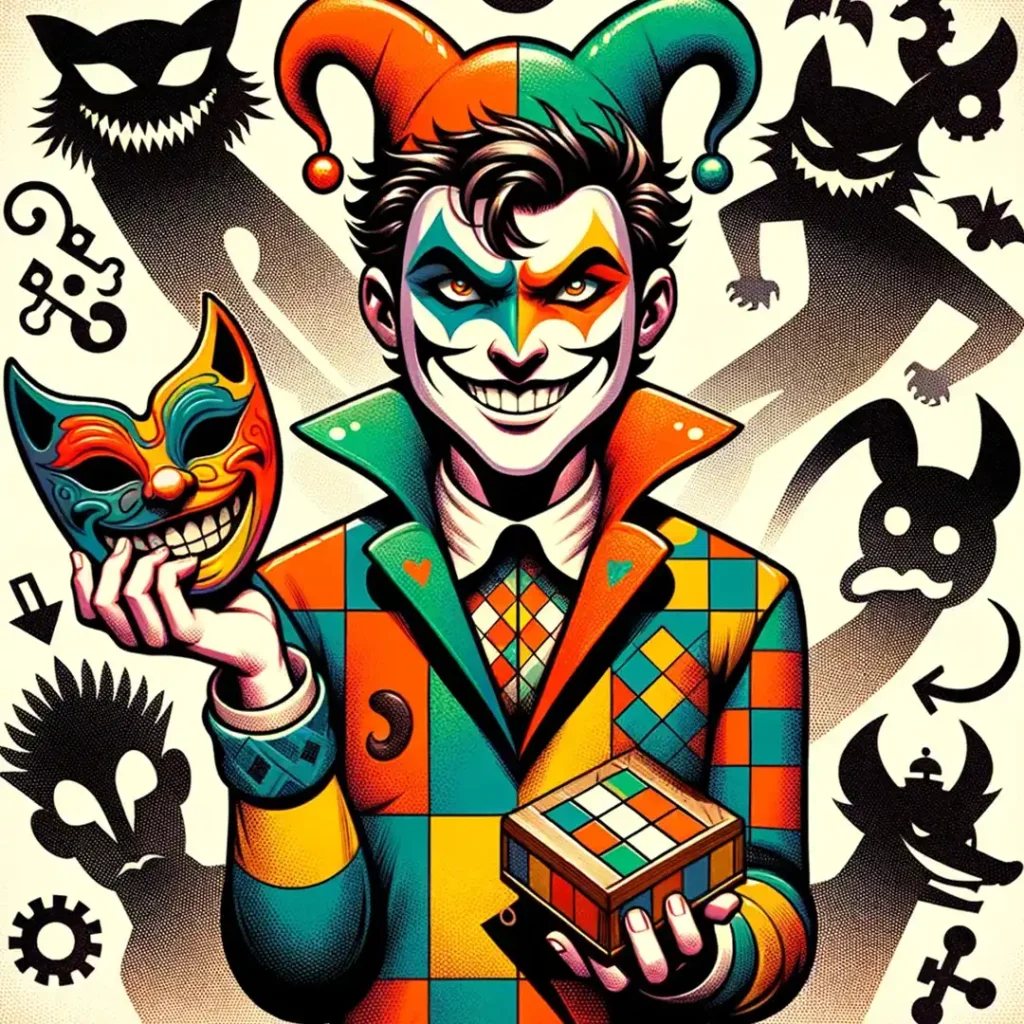
The archetype of the Trickster is a character in a story known for their cunning, mischievous nature, and tendency to break the rules and conventional behavior. The Trickster is often a catalyst for change and a disruptor of the status quo. They challenge other characters and can alter the course of the narrative through unpredictable behavior. Tricksters are shapeshifters in the metaphorical sense, navigating the story with a fluidity that both aids and complicates the Hero’s journey.
Characteristics of the Trickster archetype include a propensity for humor, wit, and the ability to cross boundaries. They often serve as a comic relief in the story but their role is much deeper—they question and mock authority, expose hypocrisy, and can bring to light uncomfortable truths that others are not willing to confront. The Trickster can be both a creator and a destroyer, a figure who provides critical insight or necessary distraction that forces characters to look at situations in new ways.
In literature, Puck from William Shakespeare’s “A Midsummer Night’s Dream” exemplifies the Trickster archetype. As a mischievous fairy, Puck’s antics and errors with a love potion create chaos and confusion among the play’s couples, leading to a series of comedic and unforeseen events that propel the various subplots of the play.
Shapeshifter
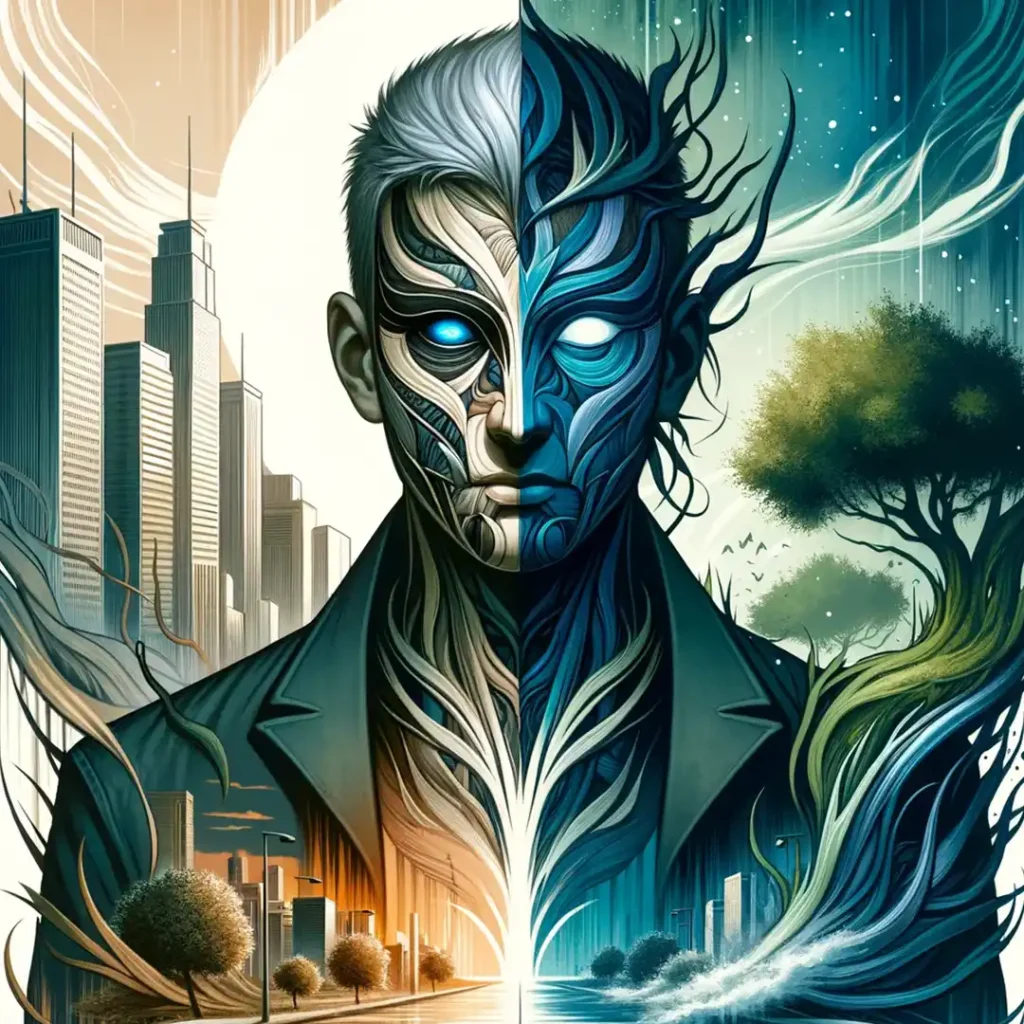
The archetype of the Shapeshifter in storytelling is a character whose motives, loyalty, or intentions are unclear, creating suspense and intrigue within the narrative. This archetype is named for their ability to “shape-shift” — metaphorically changing their demeanor, appearance, or side in the conflict as it suits their purposes. Shapeshifters are often complex, multidimensional characters who play a pivotal role in the Hero’s journey by providing tests or trials.
Characteristics of the Shapeshifter archetype include ambiguity, unpredictability, and transformation. They often contribute to the theme of appearance vs. reality in a story, as they can present one thing while being another. The uncertainty surrounding a Shapeshifter can serve to mirror the Hero’s insecurities, challenge their trust, and force the Hero to question their perceptions and beliefs.
In literature, Severus Snape from J.K. Rowling’s “Harry Potter” series is an iconic Shapeshifter. Throughout the series, Snape’s true intentions are questionable. He appears to serve the dark antagonist, Voldemort, while also showing moments of protecting Harry. The complexity of his character keeps his true allegiance hidden until the very end, revealing a depth of character that is both surprising and fitting to the narrative.
The Guardian
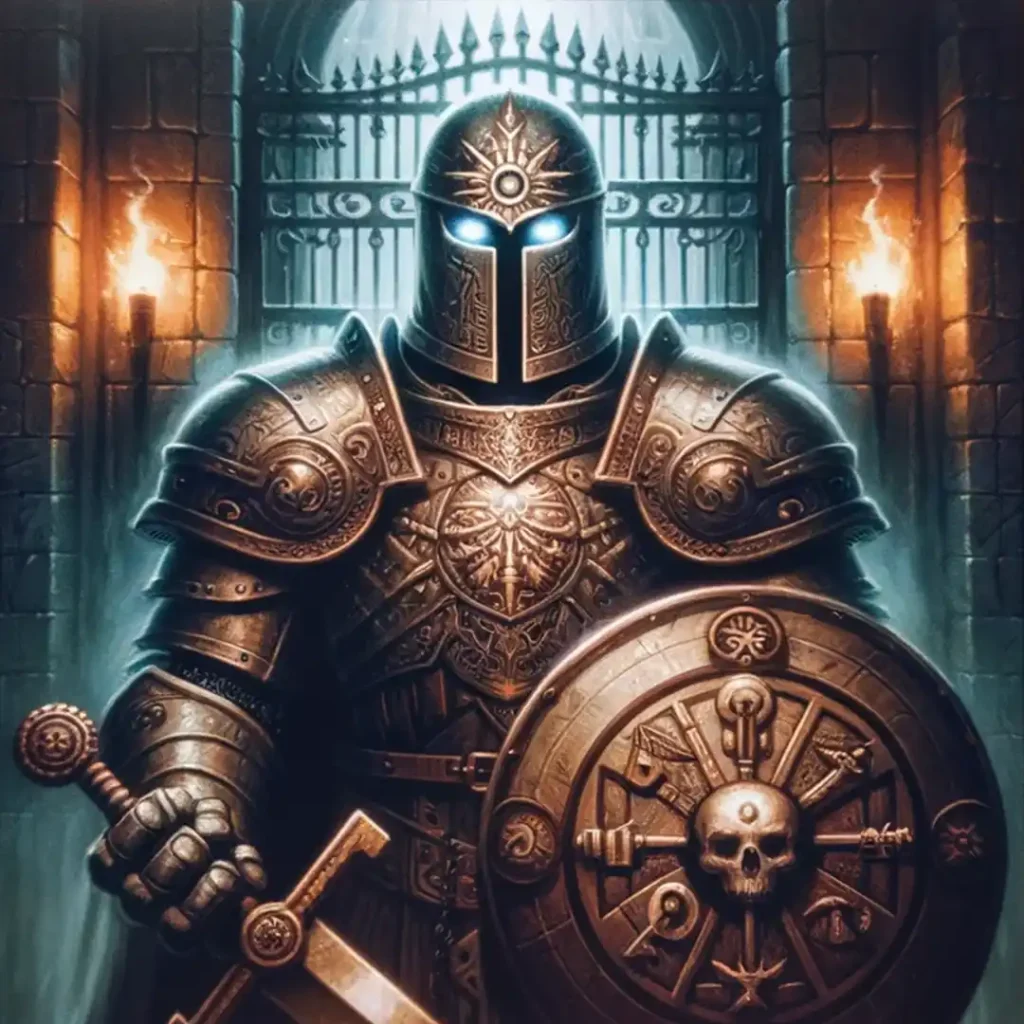
The archetype of the Guardian, also known as the Threshold Guardian, represents a challenge or obstacle the Hero must overcome to enter into a new phase of life or embark further on their journey. The Guardian stands at the precipice of important change or at critical gateways the Hero must pass through. These characters, creatures, or even situations are tests that the Hero must confront and overcome, usually to prove their worthiness, resolve, or commitment to the journey.
Characteristics of the Guardian archetype include the role of protector or keeper of a particular passage or knowledge. They are not necessarily enemies; rather, they serve as a form of quality control for the Hero’s progress and can even become allies once their challenge is met or understood. The Guardian can embody fear, doubt, or any other form of inner conflict the Hero must face and conquer in order to continue on their journey.
In literature, the Sphinx from Greek mythology, famously encountered by Oedipus, is a classic example of a Guardian. It poses a riddle that Oedipus must solve to pass and save the city of Thebes, symbolizing a gatekeeper to his own destiny and the destiny of the city.
The Shadow
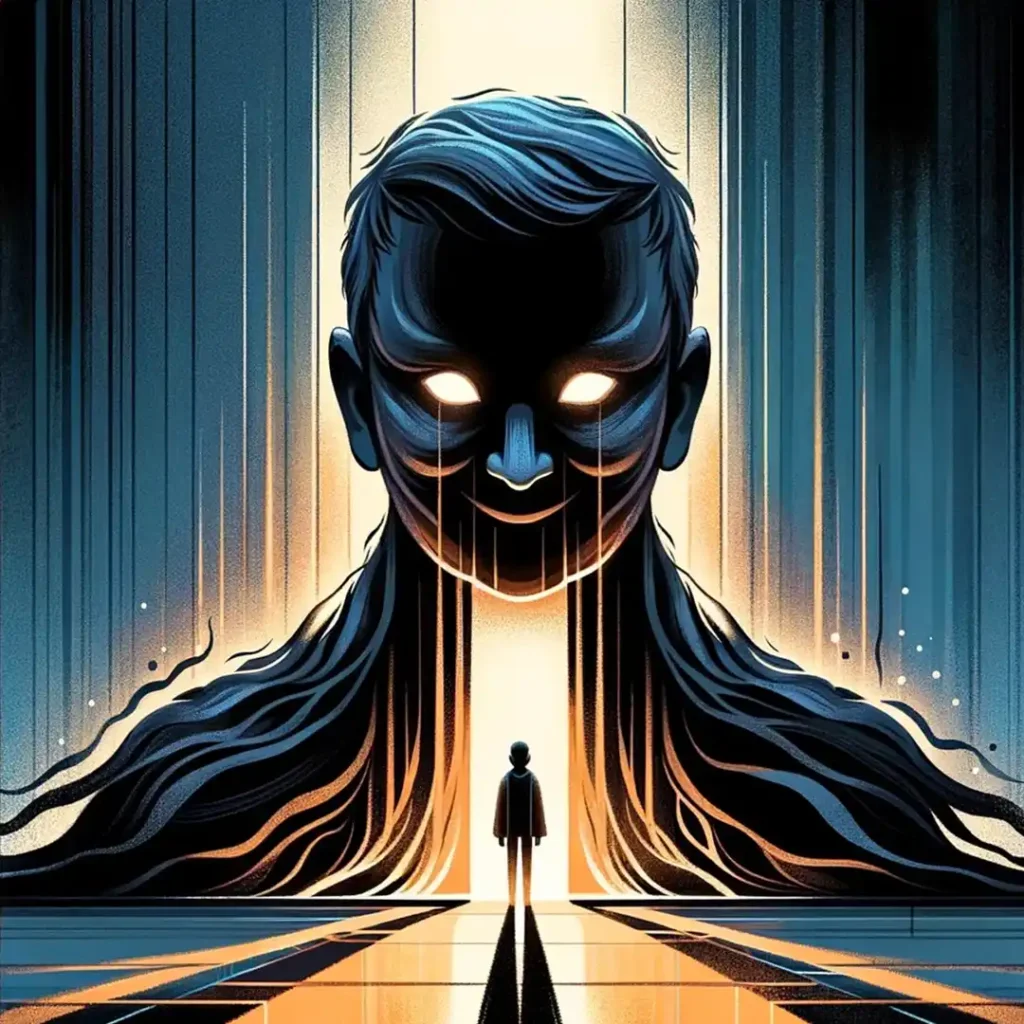
The archetype of the Shadow in storytelling embodies the darker side of humanity and often represents the antagonist or the Hero’s nemesis. This figure can be a character, group of characters, or even an inner darkness within the Hero themselves. The Shadow exists to oppose the Hero and create conflict within the story. It often represents the qualities that the Hero has rejected or prefers not to acknowledge within themselves, serving as a reflection of their greatest fears and challenges.
Characteristics of the Shadow archetype include the projection of the Hero’s inner fears, moral weakness, or flaws. The Shadow can reveal the Hero’s repressed desires or unresolved conflicts. It is not necessarily evil, though it is commonly depicted that way; rather, it represents the unexpressed or underdeveloped aspects of the Hero’s personality or the chaos and disorder challenging the Hero’s world.
In literature, the character of Voldemort in J.K. Rowling’s “Harry Potter” series is a prime example of a Shadow. He is the dark counterpart to Harry Potter, embodying the fear, power, and aggression that Harry must confront and overcome both within himself and in the external world.
In movies, Darth Vader from the “Star Wars” saga epitomizes the Shadow archetype. Representing the darkness and fear that Luke Skywalker must face, Darth Vader is not only a physical threat but also a psychological one, as he is revealed to be Luke’s father, thus embodying the darkness within the Hero’s own lineage and potential future.

